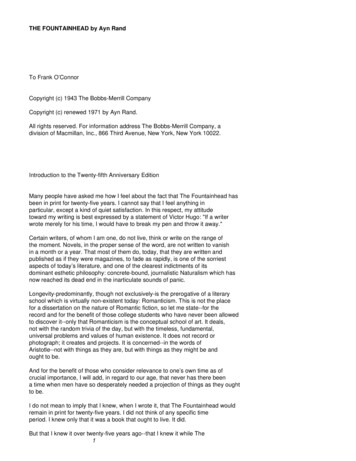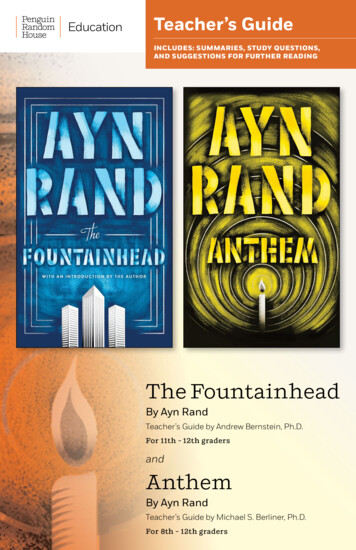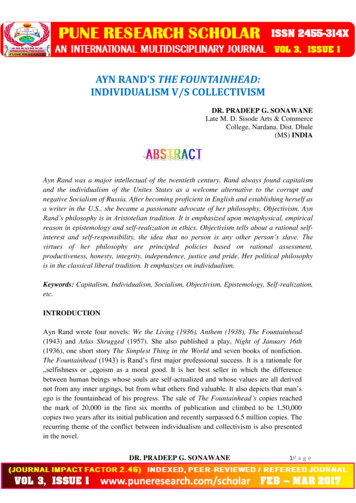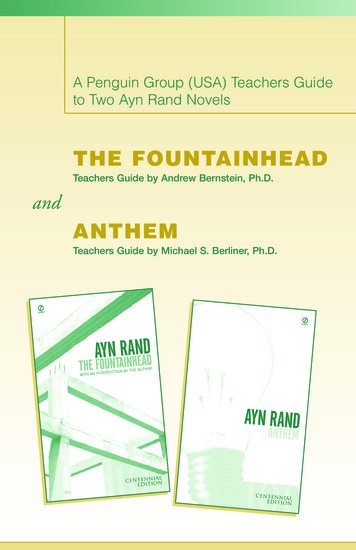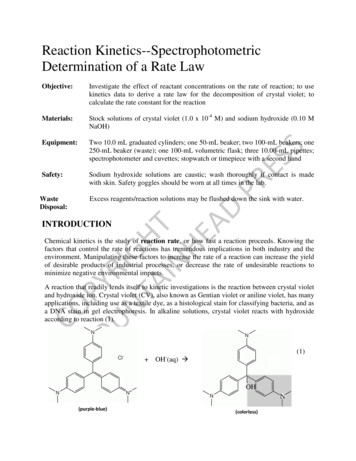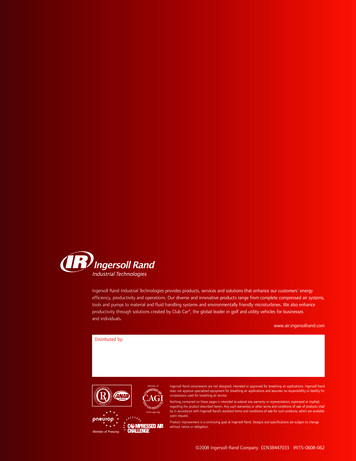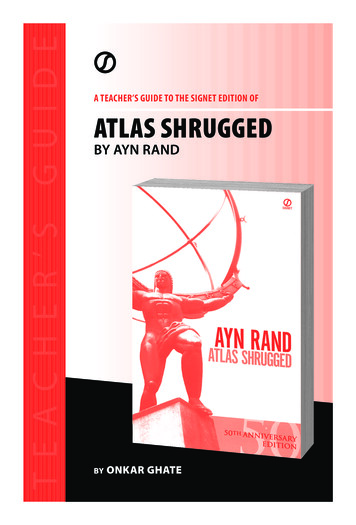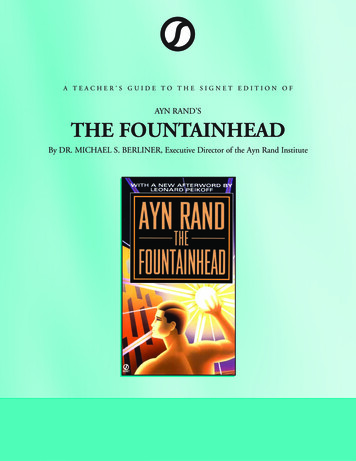
Transcription
sA TEACHER’S GUIDE TO THE SIGNET EDITION OFAYN RAND’STHE FOUNTAINHEADBy DR. MICHAEL S. BERLINER, Executive Director of the Ayn Rand Institute
A Teacher’s Guide to Ayn Rand’s The Fountainhead2INTRODUCTIONAyn Rand (1905-1982) was born in Russia and educated under the Communists, experiencing first-hand the horrors oftotalitarianism. She escaped from Russia in 1926 and came to America because it represented her individualist philosophy.The Fountainhead, published in 1943, was Ayn Rand’s first great success. It was a best seller then and continues to sellvery well today. It was made into a popular movie in 1949 starring Gary Cooper as Howard Roark and Patricia Neal asDominique Francon.The Fountainhead has achieved the status of a modern classic because it dramatically concretizes the theme ofindependence versus dependence, between following one’s own ideas or following those of others. This is of particularimportance to high-school students who are eager to assert their independence from their parents and need a code of ideasand values to guide them. The student needs to know to what extent he must follow his parents, when it is his right toassert himself against them, when and if he is being improperly influenced by peer pressure, and that it is his right to resistit. He needs to discover that social pressures pushing him toward unsatisfactory career and marriage choices are notirresistible forces defining his life—that he can oppose them successfully and often should. And he needs to discover thatunthinking rebellion against the standards of others—being different just to be different—is as abject a form ofdependence on them as blind allegiance.The Fountainhead appeals strongly to the young—and I have seen this appeal year after year, with my own high-schoolstudents—not only because its theme is independence but also because it presents “a noble vision of man’s nature and oflife’s potential” (from Ayn Rand’s Introduction to the novel). That Ayn Rand was able to integrate these issues into a plotstructure that crackles with conflict can be explained only by the school of writing to which she belongs: RomanticRealism. She is a Romantic in that she projects men as they might be and ought to be. Although not many men may becurrently living up to the ideal of independence, they have the capacity to do so, and a reason why: their success andhappiness depend on it. In this, she fundamentally differs from the Naturalist school of fiction, which is content merelyto present men as they are. (For further elaboration, see Ayn Rand’s The Romantic Manifesto.) Ayn Rand is a Realist inthat her heroes are possible and deal with the crucial real-life problems of today; her heroes are never relegated to historicalcostume dramas, other worlds, or flights of fantasy.For all the literary and intellectual achievements of The Fountainhead, it is but an overture to Ayn Rand’s greatestachievement: Atlas Shrugged. For your advanced students, who appreciate The Fountainhead and who are looking to go further,there is good news: Atlas Shrugged covers in detail the sophisticated themes that The Fountainhead begins to explore.OVERVIEWPRINCIPAL CHARACTERSHOWARD ROARK is the main character in The Fountainhead. He is a struggling young architect in the United Statesof the 1920’s and 1930’s. Roark is an early designer in the modern style. He is a brilliant, innovative genius, but his designsare often rejected by clients who want them to conform to traditional standards. Roark’s refusal to compromise causes himto lose many commissions.While Roark struggles, PETER KEATING, his rival, rises to the top of the architectural profession. He is a mediocrearchitect, but gives the public exactly what it is used to. Borrowing from other architects, including Roark, Keating sellsout any standards he has ever held in order to reach his goal of winning the approval of other people by any means.Roark’s main antagonist in the novel is ELLSWORTH TOOHEY, who is the architectural critic of influence in NewYork. Toohey, the arch villain in the novel, denounces Roark for his genius and his integrity, but Toohey’s campaign todiscredit Roark is not seen through by most people.GAIL WYNAND is Toohey’s employer. He is the talented publisher of the New York Banner, who uses his newspaper topander to the lowest public taste and thereby gain popularity and power. Meeting Roark, who he admires, he is forcedinto the most agonizing decision of his life: to continue to curry favor with the masses or live instead according to his ownstandards.DOMINIQUE FRANCON is the brilliant, passionate woman who loves Roark, but who is convinced that Roark’s geniushas no chance in a corrupt world. Roark is the catalyst for the resolution of her conflict in the novel.
A Teacher’s Guide to Ayn Rand’s The Fountainhead3U N D E R S TA N D I N G . . .HOWARD ROARKHoward Roark purses his vision of architecture with an unswerving dedication and morality that has made him aninspiration to readers. The action of the novel centers around the opposition to him from many people, all of whom arevariations on the basic theme of the novel. There are three major sources of opposition to Roark: (1) from the traditiondominated elements of society (Peter Keating); (2) from the antipathy of active powerlusters who reject his ideas in lifeand hate the independence for which he stands; and, (3) from the two figures who love him but have unresolved conflictswhich cause them in different ways to oppose Roark (Wynand and Dominique).At the opening of the novel, Roark is expelled from the prestigious Stanton Institute of Architecture. The scene betweenRoark and the Dean of the school establishes the conflict of tradition versus innovation. The Dean views Roark as a rebelwho opposes all the rules of architecture. He claims that all rules of design come from the great minds of the past, i.e.,from other people. Roark disagrees, stating that “what can be done with one substance must never be done with another.No two materials are alike. No two sites on earth are alike. No two buildings have the same purpose.Every form has itsown meaning. Every man creates his meaning and form and goal. Why is it so important—what others have done? Whydoes it become sacred by the mere fact of not being your own? Why is anyone and everyone right—so long as it’s notyourself?” This disagreement is crucial to an understanding of The Fountainhead, for the book’s central conflict is betweenpeople who are reality-centered and people who are centered instead on other people.A development of this theme is the case of the Manhattan Bank Building. The board hires Roark to design the building,ruining Roark’s plan by adding a Classic motif. As the Chairman of the Board explains: “In this way, though it’s nottraditional architecture of course, it will give the public the impression of what they’re accustomed to.” Roark tries toexplain “why an honest building, like an honest man, had to be of one piece and one faith; what constituted the lifesource, the idea in any existing thing or creature, and why—if one smallest part committed treason to that idea—the thingor the creature was dead; and why the good, the high and the noble on earth was only that which kept its integrity.” TheChairman replies, “There’s no answer to what you’re saying. But unfortunately, in practical life, one can’t always be soflawlessly consistent.” Morality to Roark is practical. To the Chairman, practicality requires one to compromise one’sstandards to be popular with others. Roark refuses to change his design, on moral grounds, and loses the job. It is thispoint that eloquently explains the personality of Peter Keating.Keating rises in his profession by two means: deception and manipulation. Keating is quite willing to be “practical” inorder to get commissions. He aspires to be successful as an architect—but the crucial point is that he does not aspire todo good work in architecture. Keating is a mediocrity, but that doesn’t matter to him, because he is able to convince hispublic that he is great. How people perceive him is Keating’s fundamental concern. For instance, he becomes an architectin the first place, not because he loves to build, but because it will gain him “social respectability.” He works for GuyFrancon, who teaches him how to impress clients by matching ties with socks and wines with foods. He gives upCatherine Halsey (whom he loves) for Dominique Francon (whom he fears) because Dominique’s beauty and connectionswill impress people.He is an example of a man who never develops values. He is what Ayn Rand calls a “second-hander:” He surrenders hiscapacity for judgment to other people, and therefore, he focuses not on what he thinks, but on what others think. Hedesigns by copying the masters of the past. Further, he gets Roark to help him whenever he needs it, taking all credit forthe design himself, and then repays Roark by publicly denouncing him. Keating is dependent, as a parasite is, on Roark,on the masters of the past, on the gullibility of the public. Keating rises because certain people support him; and as withall parasites, he falls when the host organisms withdraw their support. Toohey supports Keating for two reasons: (1) sothat the leading architect in the country will be under spiritual control; and, (2) to help destroy Roark.ELLSWORTH TOOHEYToohey is the antithesis of Howard Roark. He is the selfless altruist whose entire life revolves around other people;specifically, he wants to rule others by preaching that the individual must sacrifice himself to the group. For example, asa vocational advisor at a New York college, he gains control of his young charges by making them renounce their guidingpassions, subsequently filling their now-emptied souls with his own advice and guidance. He postures to the public as asaint of “humanitarian love”—while using this creed to help establish a Big Brother dictatorship, in which everyone
A Teacher’s Guide to Ayn Rand’s The Fountainhead4selflessly obeys the State, with Toohey as the intellectual ruler behind the throne. with this end in mind, he schemes togain control of the Wynand papers, worming his hand-picked followers into key positions, preparing for the bigshowdown with Wynand.Toohey is consistently evil. He is a parasite like Keating, but he is worse because he is not after success in some career, butafter power and destruction of others. He has a vested interest in the dependency of followers. An independent personneither needs him nor will listen to him. Therefore, Roark represents his greatest enemy. Roark cannot be ruled. This isthe reason why Toohey cannot stand Roark or stop him, cannot even touch him at a fundamental level. For Toohey ismaster only of dependent personalities. All of Toohey’s scheming is powerless against the independent judgment of therational individual.GAIL WYNANDWynand rises out of the New York slums to a position of wealth and power through hard work, determination, andbrilliance. A man of tremendous creative drive, he is frustrated and angered by the incompetence he encounters in his rise.Receiving responses of “you don’t run things around here” to any good new idea he gets, Wynand sets out to make certainthat he does indeed run things. Believing that dominance over others is the only way that real values can be achieved ina world he regards as corrupt, he sets out to dominate public opinion through his newspaper chain—which is aimed atthe lowest common denominator among men. He accepts the idea that to be successful he must sacrifice his ideas andplay to the prejudices of his readers. All of his innovative talents are then devoted to making his scandal sheet, the Banner,the most influential newspaper in New York. Wynand, the man of potential independence, becomes Wynand thedemagogue, pandering to the mob in return for their support.All of Wynand’s real, private judgments are excluded from the content of his newspaper finding expression only in hisprivate are gallery and in the selection of his wife, Dominique, and closest friend, Roark. Wynand’s nature is such that hemust admire and love Roark; but the Banner ‘s nature is such that it must oppose and denounce Roark. Wynandmistakenly thinks he can use his power to support Roark, but he finds out otherwise. Wynand believes he must sacrificehis integrity to gain power. One chooses to be either a corrupt success or an honest failure; to Wynand there is no otheralternative. This same assumption is shared by Dominique Francon in a different form. It brings her into desperateconflict with everything she loves, especially Roark.DOMINIQUE FRANCONDominique is an impassioned idealist. She is capable of positive emotion only for the noble, the pure, the exalted.Unfortunately, Dominique regards the world, not as an exalted place where greatness will flourish, not even as anindifferent place where greatness will occasionally rise only to be ignored, but as a malignant place where the rare instancesof greatness will be ruthlessly crushed. Hence, she throws down an air shaft a stature of a Greek god which she cherishes,and she joins with Toohey in an attempt to destroy the career of the man she loves. Both are acts of mercy killing—theattempt to kill quickly and painlessly that which has no place in a malignant world. Dominique is idealism combinedwith pessimism—love of the noble conjoined with the conviction that the noble has no chance in the world. She lives herlife in fear that the things she loves are in danger of imminent destruction.Like Wynand, she believes that one msut choose between corrupt success and noble failure. Unlike Wynand, sherepudiates such a success, opting instead to take no value from a corrupt world. In effect she withdraws from the world,her first-rate mind unused in any serious attempt at a successful career. After the agony of the Stoddard Temple trial, sheremoves herself from active participation in the ongoing struggle. Only with
The Fountainhead, published in 1943, was Ayn Rand’s first great success. It was a best seller then and continues to sell very well today. It was made into a popular movie in 1949 starring Gary Cooper as Howard Roark and Patricia Neal as Dominique Francon. The Fountainhead has achieved the status of a modern classic because it dramatically concretizes the theme of independence versus .
